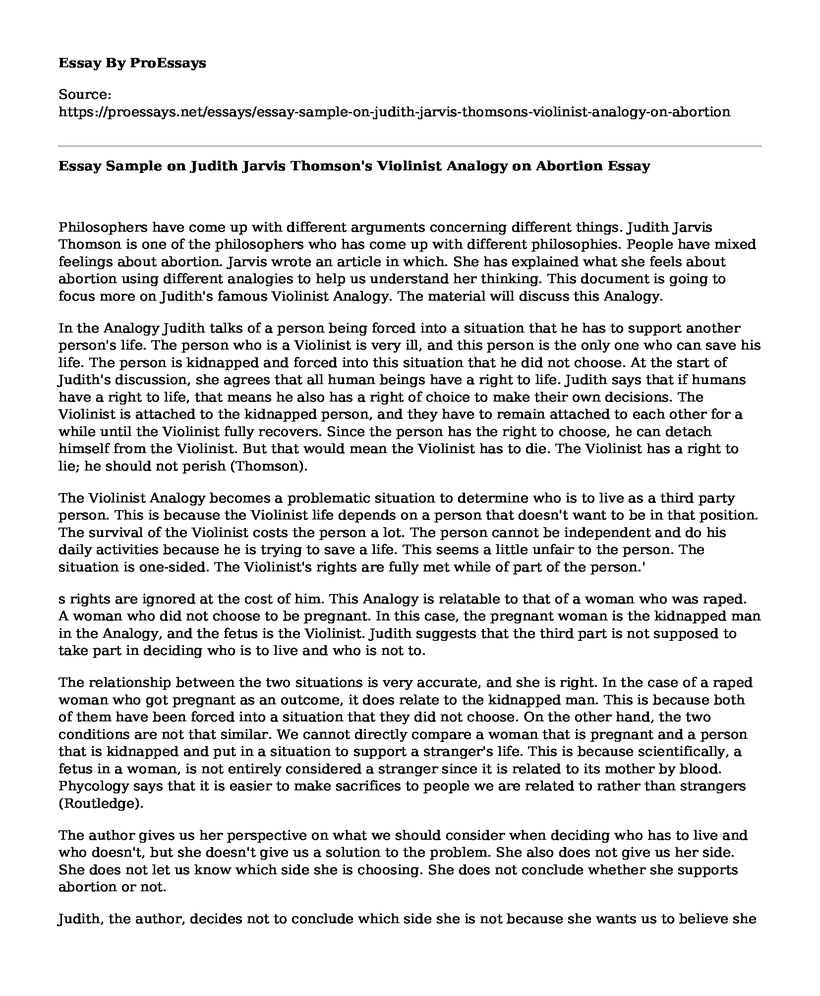Philosophers have come up with different arguments concerning different things. Judith Jarvis Thomson is one of the philosophers who has come up with different philosophies. People have mixed feelings about abortion. Jarvis wrote an article in which. She has explained what she feels about abortion using different analogies to help us understand her thinking. This document is going to focus more on Judith's famous Violinist Analogy. The material will discuss this Analogy.
In the Analogy Judith talks of a person being forced into a situation that he has to support another person's life. The person who is a Violinist is very ill, and this person is the only one who can save his life. The person is kidnapped and forced into this situation that he did not choose. At the start of Judith's discussion, she agrees that all human beings have a right to life. Judith says that if humans have a right to life, that means he also has a right of choice to make their own decisions. The Violinist is attached to the kidnapped person, and they have to remain attached to each other for a while until the Violinist fully recovers. Since the person has the right to choose, he can detach himself from the Violinist. But that would mean the Violinist has to die. The Violinist has a right to lie; he should not perish (Thomson).
The Violinist Analogy becomes a problematic situation to determine who is to live as a third party person. This is because the Violinist life depends on a person that doesn't want to be in that position. The survival of the Violinist costs the person a lot. The person cannot be independent and do his daily activities because he is trying to save a life. This seems a little unfair to the person. The situation is one-sided. The Violinist's rights are fully met while of part of the person.'
s rights are ignored at the cost of him. This Analogy is relatable to that of a woman who was raped. A woman who did not choose to be pregnant. In this case, the pregnant woman is the kidnapped man in the Analogy, and the fetus is the Violinist. Judith suggests that the third part is not supposed to take part in deciding who is to live and who is not to.
The relationship between the two situations is very accurate, and she is right. In the case of a raped woman who got pregnant as an outcome, it does relate to the kidnapped man. This is because both of them have been forced into a situation that they did not choose. On the other hand, the two conditions are not that similar. We cannot directly compare a woman that is pregnant and a person that is kidnapped and put in a situation to support a stranger's life. This is because scientifically, a fetus in a woman, is not entirely considered a stranger since it is related to its mother by blood. Phycology says that it is easier to make sacrifices to people we are related to rather than strangers (Routledge).
The author gives us her perspective on what we should consider when deciding who has to live and who doesn't, but she doesn't give us a solution to the problem. She also does not give us her side. She does not let us know which side she is choosing. She does not conclude whether she supports abortion or not.
Judith, the author, decides not to conclude which side she is not because she wants us to believe she is open-minded and not biased in her views. This is also because she does not want to conclude - that way she gives in the room for more research on her work. Also, being openly minded opens up your critical thinking. One would see different sid3es of something when they are open-minded more than when then are one-sided or biased.
Judith's discourse on abortion takes different dimensions. She makes use of different paradigms to express her thoughts as far as abortion is concerned. For instance, the Violinist and the kidnapped person analogy is used to depicting the bigger picture of a raped woman. The above-stated paradigm boils down to the concept of the right to choice and right to life. In the context of abortion, the Violinist is the fetus while the kidnapped person is a raped mother. The writer asserts that a third party has no obligation to make any decision on this matter. She should, however, come up with a more clear theory that will help us understand which side is right and why it is correct.
Works Cited
Thomson, Judith. "Judith Jarvis Thomson: A Defense Of Abortion". Spot.Colorado.Edu, 2019, https://spot.colorado.edu/~heathwoo/Phil160,Fall02/thomson.htm.
Meyer, Melissa. Thicker than water: The origins of blood as symbol and ritual. Routledge, 2014.
Cite this page
Essay Sample on Judith Jarvis Thomson's Violinist Analogy on Abortion. (2023, Feb 27). Retrieved from https://proessays.net/essays/essay-sample-on-judith-jarvis-thomsons-violinist-analogy-on-abortion
If you are the original author of this essay and no longer wish to have it published on the ProEssays website, please click below to request its removal:
- Nursing Theorists Annotated Bibliography
- Chronic Obstructive Pulmonary Disease Pathophysiology and Diagnosis - Paper Example
- Nursing and Conflict Management Questions and Answers Paper Example
- Prevention of Workplace Violence Essay Example
- Article Analysis Essay on "Trauma and Intensive Care Nursing Knowledge"
- Essay Example on Impact of Education on Nursing Practice: Evolving Scope & Quality Care
- Essay on Promoting Self-Cannulation: Applying Watson's Theory of Caring to End-Stage Renal Disease







